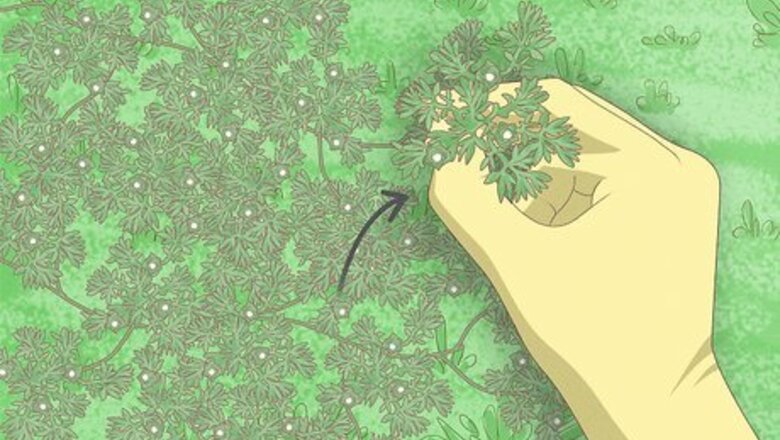
views
- Pull stickers by hand if you have a small patch of them. For larger patches, drag an old blanket across your yard to collect the stickers.
- Rake your yard or mow your lawn with a mower bag to collect the stickers in your yard.
- Apply pre-emergent herbicides in the fall to prevent stickers from forming. Spray a post-emergence herbicide on any other weeds in winter.
- Fertilize your lawn to provide turf with nutrients so it grows in stronger and keeps stickers from coming back.
Hand-pull small patches of stickers.

Pulling sticker weeds right away prevents them from spreading. Put on a pair of gardening gloves to protect your hands from the burrs. Look for the burweed, which is low-growing with dark-spotted stems and small segmented leaves. Pinch the base of the stem between your fingers and gently pull the roots out of the soil. Toss the stickers in a trash bag to keep them from spreading. Sticker weeds have shallow roots so they should be easy to uproot by hand. If you’re having trouble getting them out of the ground, use a hoe instead. Avoid tossing any sticker weeds in a compost pile since the seeds are still viable. Once you spread the compost, the seeds would sprout again.
Rake your yard to gather loose stickers.
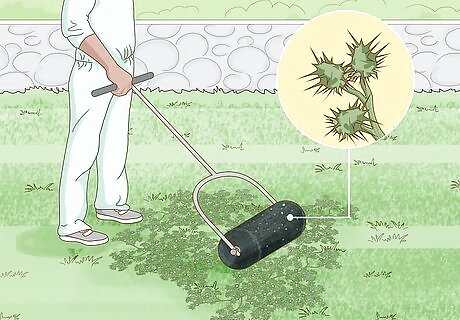
Loose stickers will break off the plant when you rake them up. Find the sticker weeds in your yard and drag a rake over the leaves. Any loose burrs will easily break off of the plant so you can easily collect them. Put on gardening gloves and toss all of the burrs you collect in a trash bag so you can get rid of them. Alternatively, you can lay a fuzzy blanket on the ground and put cinder blocks on 2 of the corners. Pull the blanket over the stickers by hand or with a riding lawnmower so the burrs stick to the fabric.
Spray vinegar on stickers before they seed.
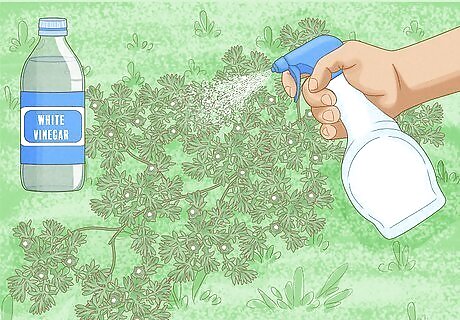
Vinegar works as a natural alternative to chemical herbicides. Fill a spray bottle with white vinegar from your kitchen. Set the nozzle on your spray bottle to a steady stream instead of a mist. On a sunny day, go into your yard to find the sticker weeds and spray their leaves with the vinegar. Reapply the vinegar once a day until the weed dies. Vinegar may also kill grass and nearby plants, so be sure to only spray the burweed when you use it. You could instead use a mixture of 1 fluid ounce (30 ml) of vodka, 2 cups (470 ml) of water, and 2 drops of dish soap to kill weeds.
Sprinkle baking soda over the stickers.
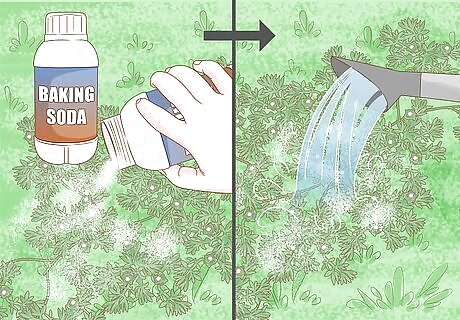
The baking soda pulls water out of the weeds so they die out. Take a pinch of baking soda and sprinkle it on top of the stickers and around the roots. Immediately water the soil so the baking soda soaks in and gets absorbed by the roots. Baking soda works best to kill stickers before they form seeds or burrs. Baking soda could harm other plants and grasses nearby, so use it sparingly.
Mow your lawn with a bag attachment.
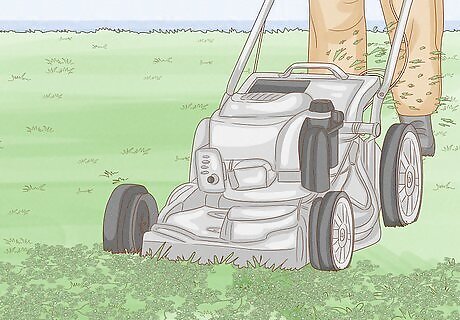
Cutting your lawn removes the sharp stickers from the weeds. Attach a mower bag onto your lawnmower to catch all of the clippings. Mow your lawn, making sure to go over the areas that have stickers. When you finish mowing your lawn, dispose of your lawn clippings at a landfill so the seeds don’t spread in your lawn. Trim off a maximum of ⅓ your lawn’s height when you mow to keep your grass healthy. Cutting your lawn shorter could make it weaker and let stickers grow in. If the sticker weeds grow shorter than your grass, mowing won’t be as effective since the blades can’t cut off the burrs.
Burn small sticker patches with a hand torch.
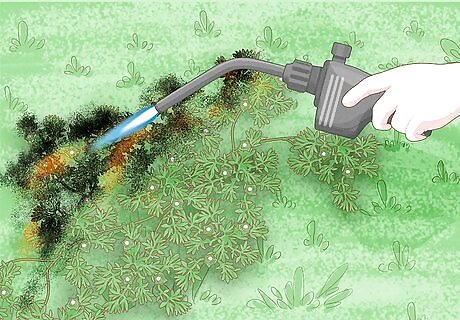
Burning patches of stickers kills the roots so they don’t grow back. Wet the grass around the patches of stickers so they’re less likely to burn. Put on safety glasses and work gloves before you start working. Use a propane hand torch so you have the most control. Turn on the torch and point the flame at stickers. Burn the plant down to the roots so it doesn’t grow back in. Keep your hose nearby so you can extinguish the flame as soon as you’re finished. You could also try pouring boiling water on a small patch of stickers to kill the plant, but be careful since it could kill nearby grass or plants.
Spray pre-emergent herbicide in the late fall.
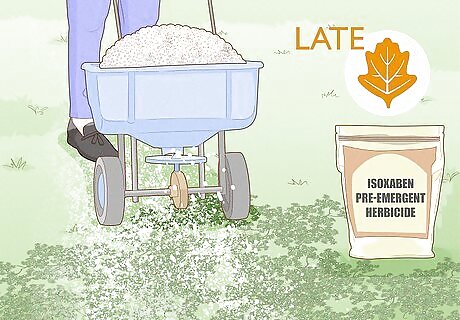
Pre-emergent herbicides prevent stickers from growing next season. Use an isoxaben pre-emergent herbicide since it’s the most effective against stopping sticker weeds from growing in. Use a garden spreader to apply the herbicide throughout your lawn in the late fall. Water your lawn immediately to help the herbicide soak into the soil so the stickers absorb it through their roots. Avoid waiting until the winter or spring to apply your herbicide since the stickers will already have germinated and formed burrs already. You may need to use a pre-emergent herbicide once a year for a few years to completely eliminate sticker weeds from your yard.
Apply post-emergent herbicide in the winter.
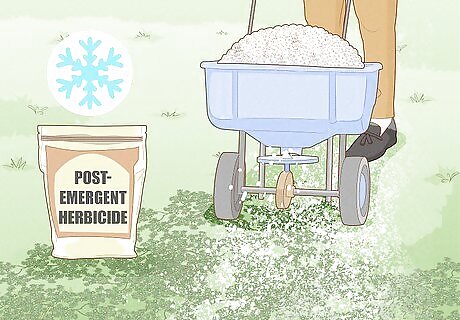
A post-emergent herbicide kills stickers before they form sharp burrs. Check that the herbicide contains either atrazine or metsulfuron since they work best to get rid of stickers. Wait until after the last frost to apply the herbicides. If you notice any sticker weeds in your lawn without spines, then the herbicide will work on them. Spread the herbicide throughout your yard and water it into the soil immediately. Spraying post-emergent herbicides later in the spring may help kill the weed, but the sharp burrs will have already formed and will still be in your yard. Avoid applying post-emergent herbicides when it’s hotter than 90 °F (32 °C) since you could damage your turfgrass.
Fertilize your lawn twice a year.
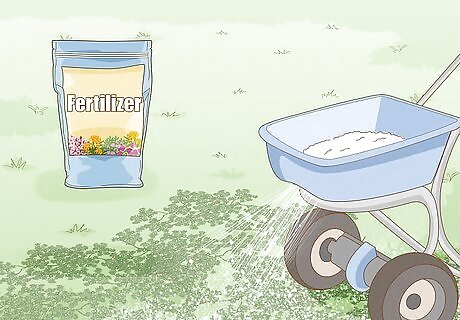
Stickers don’t grow as well when the soil is full of nutrients. Healthy grass blocks new stickers from growing in. Get a soil test kit and check your soil to see the nutrients that are missing. You can use either a granular or liquid fertilizer in your yard. Spread the fertilizer during the growing season to help support healthy new grass. Apply fertilizers at least twice a year while your grass is actively growing. Water your lawn immediately after you apply fertilizer to help it soak into the soil.












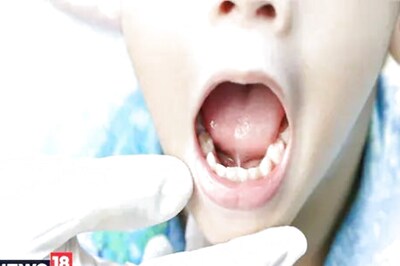





Comments
0 comment